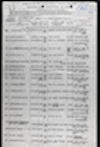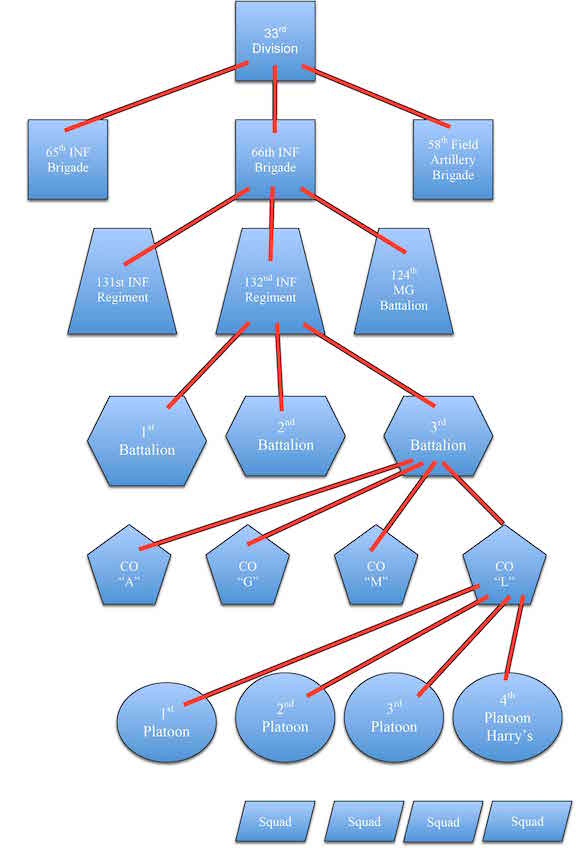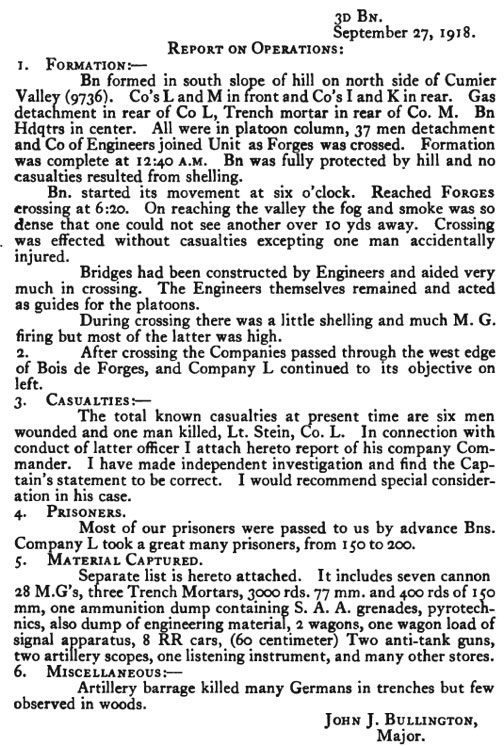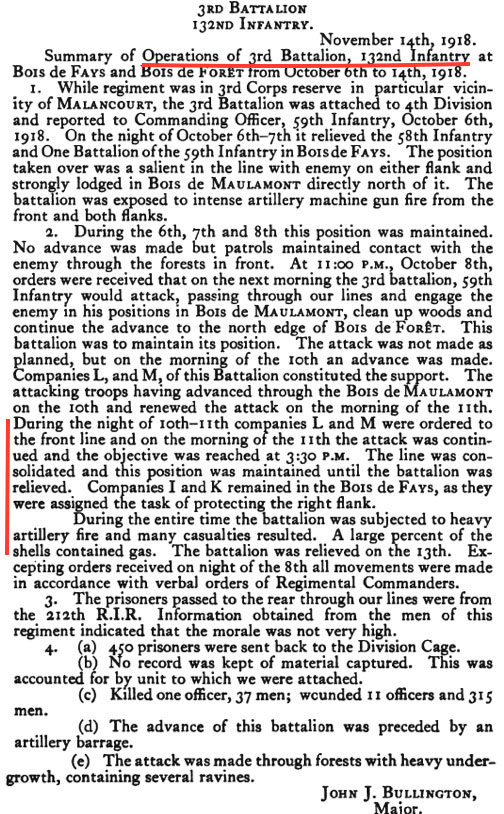NEW URLPlease visithttps://Company-L.comWorld War One |
|||||||
Company “L” |
Company “L”
of the 3rd Battalion . . .
of the 132 Infantry Regiment . . . of the 66th Brigade . . .
of the 33rd Division
“The Prairie Division”
At 2 minutes 20 seconds scenes begin of the 33rd Division returning from France on the USS Mount Vernon, May 1919. It is the same ship that took them to France in May 1918. Following are scenes of soldiers on the front lines. Our 132nd Infantry Regiment's Company L soldiers are on the ship, and possibly in the front line scenes. Footage courtesy of the Illinois State Military Museum.
This website is dedicated to the memory and sacrifices of members of Company L, especially PFC Harry Shankman, grandfather of CDR Ronald Miller, USN (Retired), creator of this website, and SGT Wesley Foster, great uncle of Edward Hudson. Ron and Ed connected a hundred years after WWI and have dedicated themselves to honoring their Company L ancestors.
|
|
| WWI Victory Medal with battle clasp Meuse-Argonne (26 Sep 1918 to 11 Nov 1918) - |
|
| WWI Victory Medal with battle clasp Defensive Sector (04 Jun 1917 to 11 Nov 1918) |
|
| The Verdun Medal was issued by the city of Verdun as a commerative. These were unofficial awards as far as the nation of France was concerned. As such, they could not be 'legally' worn on the military uniform as part of parade-dress. |
The 33 DIVISION “The Prairie Division” was comprised of soldiers from the Illinois National Guard. They trained at Camp Logan, Texas before sailing for Brest, France in May 1918. The 33rd served with the Australians at the Amines sector, and was represented by units at Verdun and at the Meuse-Argonne. As a division, the 33rd Division spent 27 days in active sectors and 32 days in quiet sectors. It captured 3,987 prisoners-a record for a National Guard Division – and advanced 36 km (22 miles) against the enemy while sustaining 989 battle deaths & 6,266 wounded. Search the Company L Roster including the 33rd Division Chain-of-Command. Data includes rank, service number, awards, stories, photos, and more.

Company L traveled to and from France on the USS Mount Vernon. It formerly was the German Kronprinzesin Cecilie built by Germany in 1906. It was commandeered and commissioned by the U.S. Navy and used as a troop transport; renamed the USS Mount Vernon in 1917, it was decommissioned in 1919.
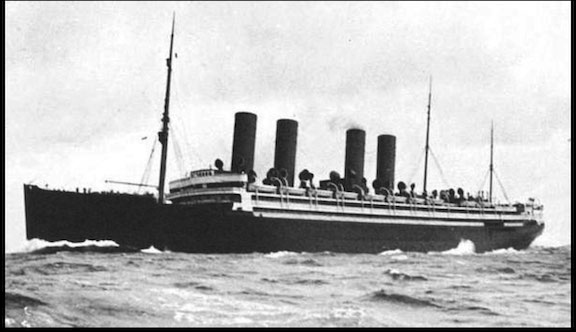
USS Mount Vernon's Company L manifests. They contain name, rank, serial number, unit assignment, and next of kin. Links below are to numbered manifest pages. Each lists approximately 40 soldiers. |
|
| Manifest index pages will open in new browser window or tab | |
May 1918 Enroute to France |
May 1919 Enroute Home |
To locate the manifest page for an individual soldier, use this search feature link:  |
|
How the 33rd Division was organized
|
| – Squads form the basis of each Infantry Platoon. Each Platoon has 4 squads. – 5 Platoons, each with about 50 soldier, comprise each company. – 4 Companies - A, G, L, & M - comprise the 3rd Battalion. There are 3 Battalions in the 132nd. – 3 Battalions total about 2,400 soldiers and comprise the 132nd Infantry Regiment. – 2 Infantry Regiments (131st & 132nd) and 1 Machine Gun Battalion comprise the 66th Brigade. – The 65th Brigade and the 66th Brigade, and the 58th Field Artillery Brigade totals 7,000 soldiers. – The Divisional Troops & Supply Trains add 3,000 for a total of about 10,000 soldiers that comprised the 33rd Division. |
Combat operations of the 132nd Infantry were along the Western Front:
About 70 miles north of Paris and extending about 135 miles east of Paris.
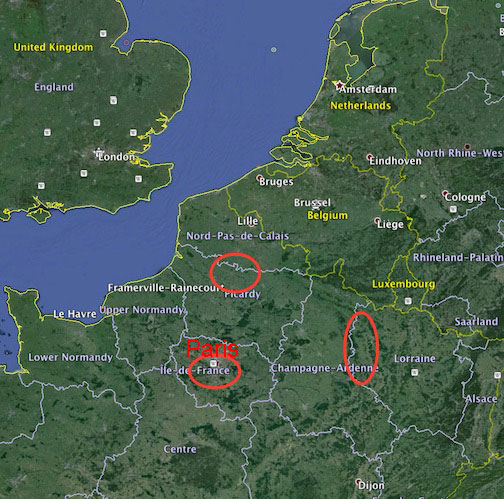
The 66th Brigade was reformed from the 1st and 2nd Illinois Regiments as part of the 33rd Division at Camp Logan, Texas, in 1917. The Brigade arrived in France aboard the Mt. Vernon at the port of Brest on May 24,1918 for service in World War I. They marched across France starting on May 26th and were within 30 miles of Metz, France when the war ended. Before the Armistice was signed the Brigade had fought at Hamel, Chippilly Ridge, Gussair Woods, the Somme Offensive, Verdun, the Meuse-Argonne Offensive and St. Mihiel during their six months in battle. After a brief period serving as part of the Army of Occupation in Luxembourg, the Brigade returned to the United States and was mustered out of federal service in May 1919. When the 132nd Infantry first arrived in France in May 1918 the Division trained with the British at Picardy from May 25th till August 23, 1918. Following this the Division occupied the Amiens Sector (Picardy) rotating trench duty. From August 8 – 13th it participated in the Somme Offensive Operation. During this time, the 3rd battalion of the 132nd Infantry Regiment, which included Company “L,” fought at the battle of Albert. During much of this time company L also rotated trench duty on the front lines. The 3rd battalion took part in the Meuse-Argonne Operations from October 6 – 13. On the nights of October 6th and 7th the 3rd battalion, including Company “L,” was attached to the 4th Division and took part in the attack on Bois De Fays. The battalion took a position in the shape of a horse shoe, with the enemy on both flanks in Bois de Maulamont. The 3rd battalion was exposed to intense artillery and machine gun fire and gas. The battalion continued its forward movement, and on the night of October 10 it advanced through Bois de Maulamont and renewed the attack on October 11, reaching the Bois de Foret which was their final objective. The advancing lines were subject to artillery fire and gas causing the unit to suffered many casualties. Hand-to-hand fighting occurred frequently and machine gun nests were numerous and strongly placed. Every foot of the advance was contested. The fighting was so fierce that the troops could not be provided with proper rations. Company “L” had every officer killed or wounded; it was commanded by the Company First Sergeant until the objective had been reached. Casualties were 38 killed, 315 wounded and gassed. During this battle the battalion captured 400 Germans. Henry FLAATA was in Company L, 2nd Platoon. The link below is an article including Henry’s WWI experiences. “Naturally, the enemy set up their own S.O.S. signals, which was the best show of fireworks I have ever seen. A man’s life at that stage was not worth much, one never knew if you could take another step or not and many never did. That day we advanced six miles. “After the battle was over, the Argonne Forest was a grim and horrible sight. So many bodies laid on the ground that we had to move them aside with our feet or step over them. Both allies and the enemy lay dead on the battlefield and with them many wounded. The wounded groaned and screamed. Some were out of their head and swearing and cursing,” Flaata continued. After the battle of Bois de Fays the 3rd battalion took positions on the Muese in the front of Donneveaux holding the line until October 21st. On October 24th they were ordered to the Troyon Sector about 30 miles southwest of Metz where they stayed until the armistice was signed. Patrols penetrated the towns of St. Hilaire, Bois de Warrville, Bois L’Epinens and the southern edges of Buttenville where they encountered contact with the enemy nightly. At 0545 on November 11th they attacked the enemy in Buttneville and drove them to the north edge of town. Later, they received word of the armistice (Signed at the 11th hour, of the 11the day, of the 11th month of the year). During this last day of the war Company “L” suffered 1 killed and 6 wounded. The 'War to end all wars' was over. The regiment was then tasked with caring for released German POW’s. They stayed in the Troyon Sector until December 7th when they marched to Saarburg, Germany, arriving December 15th. They left December 17th for Luxembourg, arriving on the 20th, where they stayed until May 1919. In early May, after being “decootied” and issued new uniforms, they returned to America, sailing from Brest, France on the same ship, the Mount Vernon, that brought them to France almost a year earlier. The ship arrived in New York Harbor on May 17, 1919. At Staten Island the ship was met by the Illinois Governor and the famous “Prairie Division” was welcomed home. The troops disembarked at Hoboken and went to Camp Mills, Long Island. From there they entrained for the return to Illinois. The request for one giant parade in Chicago by the entire Division was rejected by the War Department. Instead, the Division demobilized in June 1919 with a parade down Chicago’s State Street for each of 3 increments of troops. The 132nd’s parade was conducted on May 27, 1919. The doughboys got off the train and marched to Grant Park for a reception and visiting with their relatives. At 11 a.m. the parade began. The troops wore their service uniforms and trench helmets marked with the 33rd insignia (the yellow cross) and carried rifles, bayonets and light packs. After the parade there were banquets held at “Loop” hotels. Then the men proceeded to Camp Grant, Rockford, Illinois for their honorable discharges. |
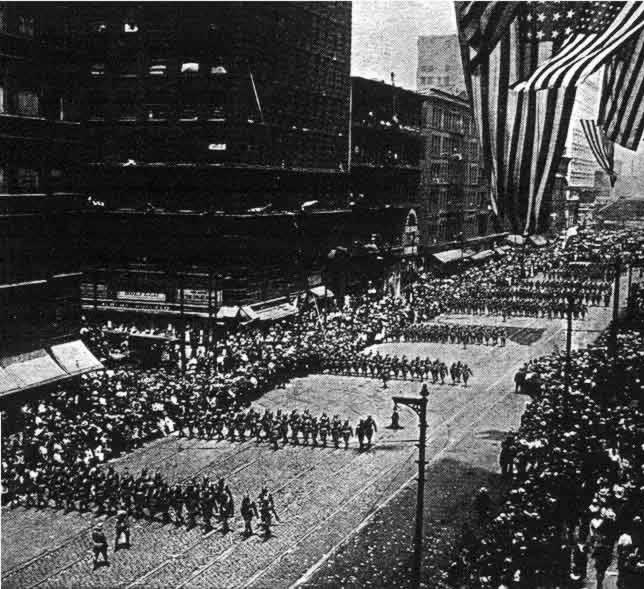
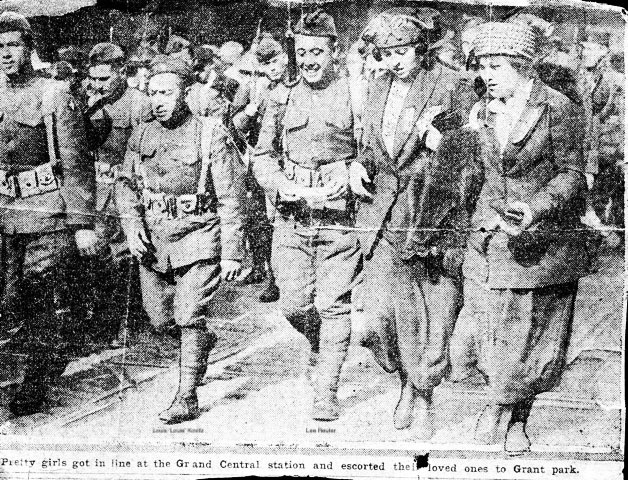
Company L Corporal Lee Reuter accompanied by two ladies with his friend Pvt Louis 'Louie' Kovits on his right.
Read operations summaries involving Company “L” during
the battles of Forges, Bois De Fays, and Bois De Foret.
| Battle of Forges | September 27, 1918 REPORT |
Company “L” in front line; officer killed. |
| Battle of Bois De Fays | October 6 – 12, 1918 REPORT |
Company “L” engages enemy. |
| Battle of Bois De Fays and Bois De Foret | October 10 & 11, 1918 REPORT | Company “L” in front line and attacked by intense artillery, machine gun, and gas. |
Postal cards and documents
Postal cards and documents give us a glimse into the daily life of the soldiers in Company “L” during their time training in Texas, while in Europe, and after the war ended. These cards and documents were in the collection of the clerk of Company “L” and are now in the archive of the Illinois Military Museum, Springfield, Illinois.
Note: Page displaying the cards will open in a new browser window or tab.
This is the official listing of Company 'L' major operational locations.
The chart below recaps major locations and operations of Company 'L'
Photos and memories from Company L descendants
- The Story of the 132d Infantry A. E. F (57 pages)
- The Story of the THIRTY-THIRD DIVISION (32 pages)
- Illinois in the World War, VOL I (684 pages)
- The 131st US Infantry in the World War (723 pages)
- Illinois in the World War, The History of the 33rd Division A.E.F. Volume I (595 pages)
- Illinois in the World War, The History of the 33rd Division A.E.F., Volume III (610 pages)
- Illinois in the World War, An Illustrated History of the 33rd Division, Volume I (428 pages)
- Gas Warfare in World War I, (Study Number 8.)
- A detailed report on the use of gas during WWI Chemical Warfare in World War I: The American Experience, 1917-1919 (120 pages)
- Gas Warfare in World War I – The 33rd Division Along The Meuse October 1918 (103 pages)



